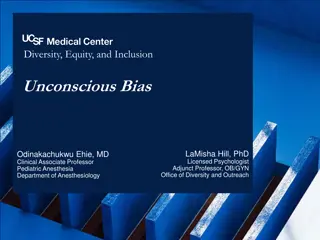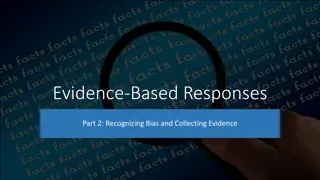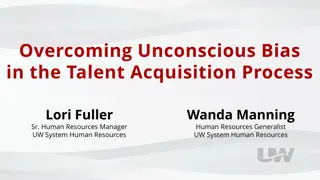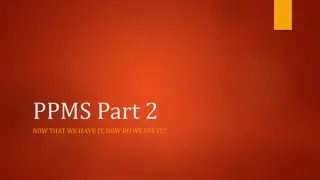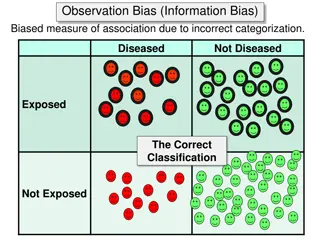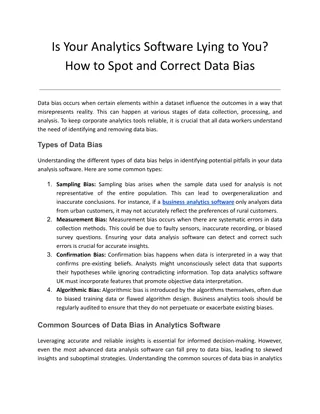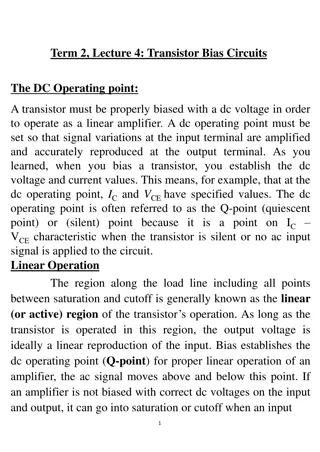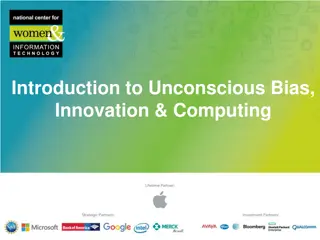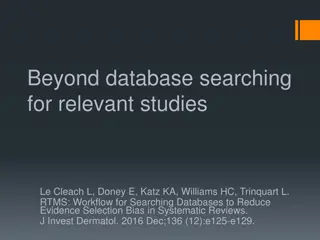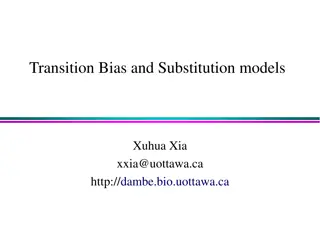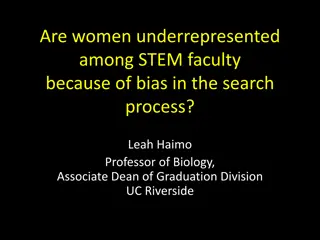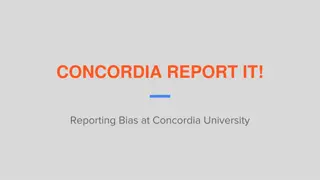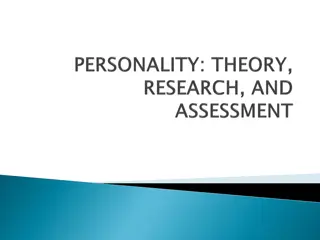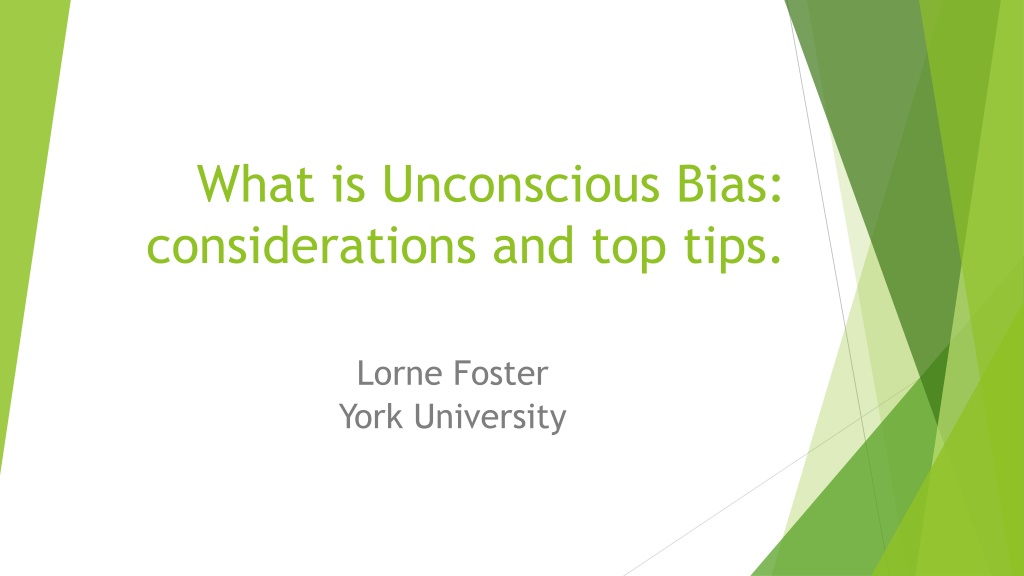
Understanding Unconscious Bias and Microaggressions
Learn about unconscious bias, microaggressions, and their impact on diversity, equity, and inclusion. Explore examples, considerations, and tips to mitigate bias in various settings. Understand how these biases affect marginalized groups and contribute to systemic inequalities.
Download Presentation

Please find below an Image/Link to download the presentation.
The content on the website is provided AS IS for your information and personal use only. It may not be sold, licensed, or shared on other websites without obtaining consent from the author. Download presentation by click this link. If you encounter any issues during the download, it is possible that the publisher has removed the file from their server.
E N D
Presentation Transcript
What is Unconscious Bias: considerations and top tips. Lorne Foster York University
Outline of Session What is Unconscious Bias: considerations and top tips. 1. Overview What is Unconscious Bias 2. Examples of Unconscious Bias 3. Mitigate - what can you do 4. Case studies
The Reality Despite multicultural narratives, data show how equity and diversity have become diversifying whiteness projects: White people constitute 96% of judges (Tutton, 2016), 93% of corporate boards (McFarland, 2014), 86.4% of MPs (Tulley, 2015), and 82% of university professors (CAUT, 2010). Racialized Canadians earn only 81.4 cents for every dollar paid to non-racialized Canadians. Canadian Association of University Teachers (CAUT). 2010. The Changing Academy? A Portrait of Canada s University Teachers. January | Vol 12 No 1. Tolley, E. 2015. Framed: Media and the Coverage of Race in Canadian Politics. Vancouver: UBC Press. Tutton, M. 2016. Canada must boost racial diversity in judiciary of whiteness, advocates urge. The Canadian Press, July 18.
What is Unconscious Bias? Unconscious bias refers to a bias that we are unaware of, and which happens outside of our control. It is a bias that happens automatically and is triggered by our brain making quick judgments and assessments of people and situations, influenced by our background, cultural environment and personal experiences
Microaggression Microaggressions: everyday verbal, nonverbal, and environmental slights, snubs, or insults, whether intentional or unintentional, which communicate hostile, derogatory, or negative messages to target persons based solely upon their marginalized group membership. - Derald Wing Sue, Ph.D.
Microaggression Examples Failing to learn to pronounce or continuing to mispronounce the names of students after they have corrected you. Scheduling tests and project due dates on religious or cultural holidays. Using the term illegals to reference undocumented students. Expecting students of any particular group to represent the perspectives of others of their race, gender, etc. in class discussions or debates. Using sexist language. Using heteronormative metaphors or examples in class. Complimenting non-white students on their use of good English. Making assumptions about students and their backgrounds. Featuring pictures of students of only one ethnicity or gender on the school website. Having students engage in required reading where the protagonists are always white.
2019 The Canada Border Services Agency The Canada Border Services Agency (CBSA) Officer Findings: Border officers order secondary inspections for travellers from the Middle East, Africa and the Caribbean at far higher rates than for travellers from the U.S. or Western Europe. Iranian travellers arriving in Canada in 2017 were on average about twenty times as likely to be referred to secondary inspections for Customs purposes and about six times as likely to be referred for immigration purposes as were visiting Icelanders. I. Jamaican visitors were approximately ten times as likely as a Dane to face a secondary inspection for Customs purposes, and almost ten times as likely to be followed up for immigration purposes. II. Border officers are more likely to look twice at the customs declaration of a returning Canadian traveller than that of a U.S. visitor. The new Primary Inspection Kiosks (PIK) that read passports ( facial recognition ) at some Canadian airports may have higher error rates when processing people with certain ethnic backgrounds.
African Canadian vs. Black Recent association research in the United States even suggests that people tend to be much more disposed to the identification of people as African American as opposed to those who identify as Blacks , and this can have remunerative consequences particularly for professionals (Hall, Phillips & Townsend, 2015). Through a series of tests, the researchers concluded the stereotype content for Blacks was significantly more negative than for African-Americans. In contrast, the stereotype content for African-Americans did not significantly differ in perceived negativity from that of Whites. The research findings suggest that image embedded in the Black stereotype is generally more negative, and less warm and competent, than that in the African-American stereotype. These different associations carry consequences for how Whites perceive Americans of African descent are labeled with either term.
What can we do? Be awareness/ conscious Considerations / vigilance Small changes Challenging stereotypes and counter stereotypical information Using context to explain a situation Changing perception and relationship with out-group members Being an active bystander Improving processes, policies & procedures
Summary We all have unconscious biases and we are all affected by bias We can take action to manage the impact on our behaviour and decision making It s up to individuals to decide what action to take 1.Introduction to Unconscious Bias 2.Examples of Unconscious Bias 3.Mitigating Unconscious Bias


